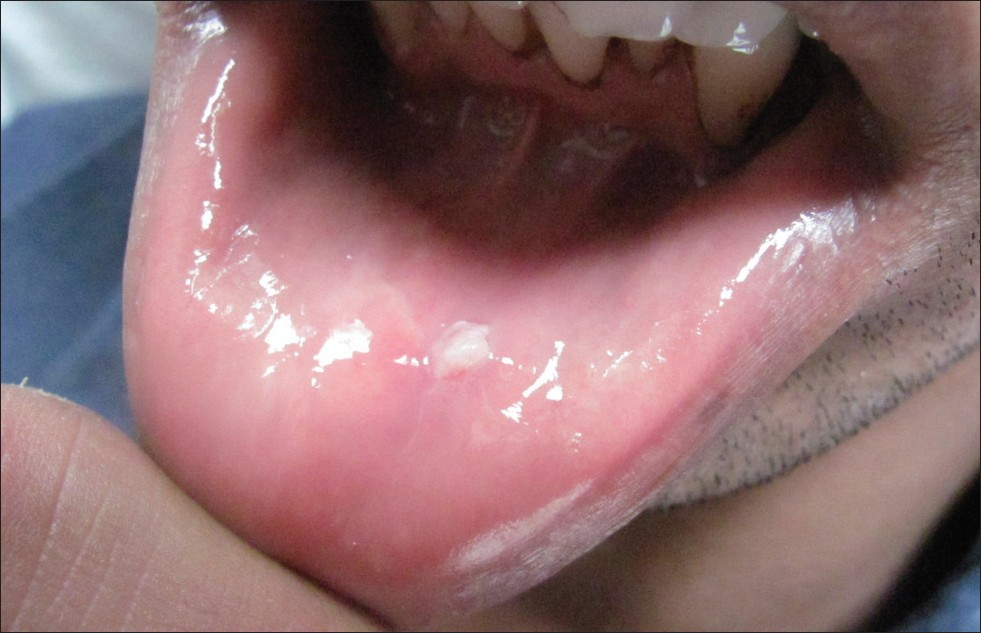Translate this page into:
Phenolisation as a Mode of Treatment of Mucosal Cysts
Address for correspondence: Mrs. S N Sujaya, Department of Dermatology, STD and Leprosy, Bangalore Medical College and Research Institute, Bangalore, Karnataka, India. E-mail: sujayasn@gmail.com
This is an open-access article distributed under the terms of the Creative Commons Attribution-Noncommercial-Share Alike 3.0 Unported, which permits unrestricted use, distribution, and reproduction in any medium, provided the original work is properly cited.
This article was originally published by Medknow Publications & Media Pvt Ltd and was migrated to Scientific Scholar after the change of Publisher.
Abstract
Mucous cysts are one of the common cystic lesions of minor salivary glands seen mostly on mucous surface of lower lip and buccal mucosa. Many modalities of treatment for mucosal cysts exist including excision and suturing, deroofing, marsupialization, radiosurgery and cryotherapy. We have used 88% phenol as a mode of treatment of mucosal cysts.
Keywords
Salivary glands
mucosal cyst
Phenol
INTRODUCTION
Mucosal cysts of the minor salivary glands are oral soft-tissue lesions that arise as dome-shaped swellings seen commonly on mucosal surface of lower lips and buccal mucosa. Small and superficial lesions do not need treatment as they heal after spontaneous rupture. Many modalities of treatment for mucosal cysts exist, including excision and suturing, deroofing,[1] marsupialisation, radiosurgery and cryotherapy.[23] We have found good results with use of 88% phenol.
Four patients of age between 9 and 25 years were treated between June and December 2011. A male patient aged 9 years had a dome-shaped smooth, tense, bluish cyst of size 5 mm on the lower lip. The second patient was a female aged 24 years, with a mucosal cyst of 4 mm on the buccal mucosa. The third patient, a female aged 21 years, had a lesion of size 6 mm in the buccal mucosa. The fourth patient was a male patient aged 25 years, who had a recurrent mucosal cyst [Figure 1] in the buccal mucosa which was treated 10 months back by electrocautery.

- Mucosal cyst on buccal mucosa
Relevant laboratory tests were done prior to the procedure. No local anaesthesia was used. Under aseptic precautions, a very small quantity of 88% phenol was injected into the cyst cavity using insulin syringes [Figure 2]. No dressing was given afterwards. Patients were given analgesics post procedure for 1 day.

- Injection of 0.1cc of 88% phenol into cyst
The procedure was uneventful in all the cases. Two of the patients complained of slight burning sensation during the procedure, which subsided within a few minutes. The patients were called after 1 week. Ulceration of the lesions was noticed. This was followed by complete healing with slight scarring within 2 weeks [Figure 3].

- Healing with slight scar
DISCUSSION
Mucoceles are fairly common conditions. Although not associated with significant morbidity, they can be the cause of discomfort. Although many other modalities of treatment of mucosal cysts exist, intralesional 88% phenol presents a simple and effective way of treating them. 88% phenol acts as a local cauterant[45] causing ablation of the cyst. The advantage is that there is no intraoperative or postoperative bleeding, there are minimal surgical defects and there is minimal scarring. No systemic complication of phenol was noted in any of our patients. Hence, intralesional injection of 88% phenol presents an easy and effective way for treatment of mucosal cysts.
Source of Support: Nil.
Conflict of Interest: None declared.
REFERENCES
- Cryosurgical treatment of benign lesions. In: Roenigk RK, Roenigk HH Jr, eds. Dermatologic surgery principles and practice (2nd ed). New York: Marcel Dekker Inc; 1996. p. :245-72.
- [Google Scholar]
- Disorders of oral cavity and mucous membranes. In: IADVL textbook and color atlas of Dermatology (3rd ed). Mumbai: Bhalani Publishing House; 2001.
- [Google Scholar]
- Chemical peeling with phenol: For the treatment of stable vitiligo and alopecia areata. Indian J Dermatol Venereol Leprol. 1999;65:93-8.
- [Google Scholar]
- Antiseptics, disinfectants, insecticides and pharmacotherapy of skin diseases. In: Satoskar RS, Bhandarkar SD, eds. Pharmacology and pharmacotherapeutics. Bombay: Popular Prakashan; 1993. p. :734-59.
- [Google Scholar]






